Looking for Parasites as Potential Biological Tags for Pacific Thread Herring, Opisthonema libertate (Günther, 1867) (Clupeiformes, Dorosomatidae), in the Gulf of California
Abstract
1. Introduction
2. Materials and Methods
3. Results
4. Discussion
4.1. Parasite Species
4.2. Infection-Level Changes
4.3. Potential Biological Tags
4.4. Limitations
5. Conclusions
Author Contributions
Funding
Institutional Review Board Statement
Informed Consent Statement
Data Availability Statement
Acknowledgments
Conflicts of Interest
References
- Berry, D.H.; Barret, I. Gillraker analysis and speciation in the thread herring genus Opisthonema. Bull. Inter-Amer. Trop. Tuna Comm. 1963, 7, 137–190. [Google Scholar]
- Cury, P.; Bakun, A.; Crawford, R.J.; Jarre, A.; Quinones, R.A.; Shannon, L.J.; Verheye, H.M. Small pelagics in upwelling systems: Patterns of interaction and structural changes in “wasp-waist” ecosystems. ICES J. Mar. Sci. 2000, 57, 603–618. [Google Scholar] [CrossRef]
- Hernández-Padilla, J.C.; Ruíz-Barreiro, T.M.; Salcedo-Bojórquez, S.; Espinosa-Romero, M.J.; Zetina-Rejón, M.J.; Arreguín-Sánchez, F. The ecological role of Opisthonema libertate and Cetengraulis mysticetus on ecosystem order in the southeastern Gulf of California, Mexico. Turk. J. Fish. Aquat. Sci. 2017, 17, 713–724. [Google Scholar] [CrossRef] [PubMed]
- Ruiz, L.; Lyle, F. Periodic fluctuations capture thread herring (Opisthonema spp.) in the Gulf of California, 1972–1990. CalCOFI Rep. 1992, 33, 124–129. [Google Scholar]
- Ruiz-Domínguez, M.; Quiñonez-Velázquez, C. Age, growth, and mortality of Opisthonema libertate on the coasts of northwestern Mexico. Cien. Mar. 2018, 44, 235–250. [Google Scholar] [CrossRef]
- Lanz, E.; Nevárez-Martínez, M.; López-Martínez, J.; Dworak, J.A. Small pelagic fish catches in the Gulf of California associated with sea surface temperature and chlorophyll. CalCOFI 2009, 50, 134–146. [Google Scholar]
- Ruiz-Domínguez, M.; Quiñonez-Velázquez, C.; Arizmendi-Rodríguez, D.I.; Gómez-Muñoz, V.M.; Nevárez-Martínez, M.O. Assessment of the exploitable biomass of thread herring (Opisthonema spp.) in northwestern Mexico. Acta Oceanol. Sin. 2021, 40, 53–65. [Google Scholar] [CrossRef]
- Pérez-Quiñonez, C.I.; Quiñonez-Velázquez, C.; García-Rodríguez, F.J. Detecting Opisthonema libertate (Günther, 1867) phenotypic stocks in northwestern coast of Mexico using geometric morphometrics based on body and otolith shape. Lat. Am. J. Aquat. Res. 2018, 46, 779–790. [Google Scholar] [CrossRef]
- Begg, G.A.; Waldman, J.R. An holistic approach to fish stock identification. Fish. Res. 1999, 43, 35–44. [Google Scholar] [CrossRef]
- Timi, J.T.; Poulin, R. Why ignoring parasites in fish ecology is a mistake. Int. J. Parasitol. 2020, 50, 755–761. [Google Scholar] [CrossRef]
- Moore, B.R.; Welch, D.J.; Newman, S.J.; Lester, R.J.G. Parasites as indicators of movement and population connectivity of a non-diadromous, tropical estuarine teleost: King threadfin Polydactylus macrochir. J. Fish Biol. 2012, 81, 230–252. [Google Scholar] [CrossRef] [PubMed]
- Poulin, R.; Kamiya, T. Parasites as biological tags of fish stocks: A meta-analysis of their discriminatory power. Parasitology 2015, 142, 145–155. [Google Scholar] [CrossRef] [PubMed]
- Jacobson, K.; Baldwin, R.; Banks, M.; Emmett, R. Use of parasites to clarify residency and migration patterns of Pacific sardine (Sardinops sagax) in the California Current. Fish. Bull. 2019, 117, 196–211. [Google Scholar] [CrossRef]
- MacKenzie, K.; Abaunza, P. Parasites as biological tags for stock discrimination of marine fish: A guide to procedures and methods. Fish. Res. 1998, 38, 45–56. [Google Scholar] [CrossRef]
- Cantatore, D.M.P.; Timi, J.T. Marine parasites as biological tags in South American Atlantic waters, current status and perspectives. Parasitology 2015, 142, 5–24. [Google Scholar] [CrossRef]
- Pérez-Ponce de León, G.; García Prieto, L.; Rosas Villa, C. Helmintofauna de Opisthonema libertate y Harengula thrissina (Osteichthyes: Clupeidae) de la bahía de Chamela, Jalisco, México. Rev. Biol. Trop. 2000, 48, 759–763. [Google Scholar]
- Bush, A.O.; Lafferty, K.D.; Lotz, J.M.; Shostak, A.W. Parasitology meets ecology on its own terms: Margolis et al. revisited. J. Parasitol. 1997, 83, 575–583. [Google Scholar] [CrossRef]
- Reiczigel, J.; Marozzi, M.; Fábián, I.; Rózsa, L. Biostatistics for parasitologists—A primer to quantitative parasitology. Trends Parasitol. 2019, 35, 277–281. [Google Scholar] [CrossRef]
- Schnute, J.T.; Boers, N.; Haigh, R.; Grandin, C.; Johnson, G.; Wessel, P.; Antonio, F. Mapping Fisheries Data and Spatial Analysis Tools. R Package Version 2.66.53. 2013. Available online: http://CRAN.R-project.org/package=PBSmapping (accessed on 2 May 2023).
- Gerritsen, H. Mapplots: Data Visualisation on Maps. R Package Version 1.4. 2013. Available online: http://CRAN.R-project.org/package=mapplots (accessed on 2 May 2023).
- R Core Team. R: A Language and Environment for Statistical Computing; R Foundation for Statistical Computing: Vienna, Austria, 2022; Available online: https://www.r-project.org/ (accessed on 2 May 2023).
- Clarke, K.R.; Gorley, R. PRIMER v7: User Manual/Tutorial; Primer-E Limited: Plymouth, UK, 2015. [Google Scholar]
- Anderson, M.J.; Gorley, R.N.; Clarke, R.K. Permanova+ for Primer: Guide to Software and Statistical Methods; Primer-E Limited: Plymouth, UK, 2008. [Google Scholar]
- Santos, C.P.; Kohn, A. Description of Cribomazocraes travassosi n. sp. (Monogenea: Mazocraeidae), a fish parasite from the Atlantic Ocean. Mem. Inst. Oswaldo Cruz 1992, 87, 247–250. [Google Scholar] [CrossRef]
- Luque, J.L.; Vinas, R.A.; Paraguassú, A.R.; Alves, D.R. Metazoários Parasitos das sardinhas Sardinella brasiliensis e Harengula clupeola (Osteichthyes, Clupeidae) do litoral do Estado do Rio de Janeiro, Brasil. Rev. Uni. Rural. Ser. Cien. Vida 2000, 22, 71–76. [Google Scholar]
- Moreira, J.; Paschoal, F.; Cezar, A.D.; Luque, J.L. Community ecology of the metazoan parasites of Brazilian sardinella, Sardinella brasiliensis (Steindachner, 1879) (Actinopterygii: Clupeidae) from the coastal zone of the State of Rio de Janeiro, Brazil. Braz. J. Biol. 2015, 75, 736–741. [Google Scholar] [CrossRef] [PubMed]
- Chaves, L.; Paschoal, F. Community ecology of the metazoan parasites of the Atlantic thread herring, Opisthonema oglinum (Lesueur, 1818) (Actinopterygii: Clupeidae) from the Sepetiba Bay, Rio de Janeiro, Brazil. Braz. J. Biol. 2020, 81, 418–423. [Google Scholar] [CrossRef] [PubMed]
- da Silva, R.D.; Benicio, L.; Moreira, J.; Paschoal, F.; Pereira, F.B. Parasite communities and their ecological implications: Comparative approach on three sympatric clupeiform fish populations (Actinopterygii: Clupeiformes), off Rio de Janeiro, Brazil. Parasitol. Res. 2022, 121, 1937–1949. [Google Scholar] [CrossRef] [PubMed]
- Hargis, W.J. Monogenetic trematodes of Gulf of Mexico fishes. part VII: The superfamily Diclidophoroidea Price, 1936 (Continued). Quart. J. Florida Acad. Sci. 1955, 18, 113–119. [Google Scholar]
- Sroufe Jr, S.A. Mazocraeoides olentangiensis, n. sp., a monogenetic trematode parasitic on the gills of the gizzard shad, Dorosoma cepedianum (Le Sueur). J. Parasitol. 1958, 44, 643–646. [Google Scholar] [CrossRef]
- Kohn, A.; Santos, C.P. First report of Mazocroeoides georgei price, 1936 and Mazocraeoides opisthonema Hargis, 1955 in Brazil with new synonysms (Monogenea, Mazocraeidae). Mem. Inst. Oswaldo Cruz 1988, 83, 437–440. [Google Scholar] [CrossRef]
- Alarcos, A.J.; Etchegoin, J.A. Parasite assemblages of estuarine-dependent marine fishes from Mar Chiquita coastal lagoon (Buenos Aires Province, Argentina). Parasitol. Res. 2010, 107, 1083–1091. [Google Scholar] [CrossRef]
- Sailaja, B.; Shameem, U.; Madhavi, R. Four species of Mazocraeoides Price, 1936 (Monogenea: Mazocraeidae), including two new species from clupeiform fishes off Visakhapatnam coast, Bay of Bengal. Zootaxa 2019, 4608, 233. [Google Scholar] [CrossRef]
- Quiroz-Martínez, B.; Salas-de-León, D.A.; Gil-Zurita, A.; Monreal-Gómez, M.A.; Coria-Monter, E.; Durán-Campos, E. Latitudinal and archipelago effect on the composition, distribution, and abundance of zooplanktonic organisms in the Gulf of California. Oceanologia 2023, 65, 371–385. [Google Scholar] [CrossRef]
- Marcogliese, D.J. The role of zooplankton in the transmission of helminth parasites to fish. Rev. Fish Biol. Fish. 1995, 5, 336–371. [Google Scholar] [CrossRef]
- Jiménez-Pérez, L.C.; Lara-Lara, J.R. Zooplankton biomass and copepod community structure in the Gulf of California during the 1982–1983 El Niño event. CalCOFI Rep. 1988, 29, 122–128. [Google Scholar]
- Soto-Mardones, L.; Marinone, S.G.; Parés-Sierra, A. Time and spatial variability of sea surface temperature in the Gulf of California. Cien. Mar. 1999, 25, 1–30. [Google Scholar] [CrossRef]
- Aceves-Medina, G.; Jiménez-Rosenberg, S.P.A.; Hinojosa-Medina, A.; Funes-Rodríguez, R.; Saldierna-Martínez, R.J.; Smith, P.E. Fish larvae assemblages in the Gulf of California. J. Fish Biol. 2004, 65, 832–847. [Google Scholar] [CrossRef]
- Portela, E.; Beier, E.; Barton, E.D.; Castro, R.; Godínez, V.; Palacios-Hernández, E.; Fiedler, P.C.; Sánchez-Velasco, L.; Trasviña, A. Water masses and circulation in the tropical Pacific off central Mexico and surrounding areas. J. Phys. Oceanogr. 2016, 46, 3069–3081. [Google Scholar] [CrossRef]
- Gutiérrez-Bravo, J.G.; Tenorio-Fernandez, L.; Jiménez-Rosenberg, S.P.; Sánchez-Velasco, L. Three-dimensional distribution of larval fish habitats at the entrance of the Gulf of California in the tropical-subtropical convergence region off Mexico (April 2012). J. Plankton Res. 2022, 44, 130–144. [Google Scholar] [CrossRef]
- Studer, A.; Poulin, R. Seasonal dynamics in an intertidal mudflat: The case of a complex trematode life cycle. Mari. Ecol. Prog. Ser. 2012, 455, 79–93. [Google Scholar] [CrossRef]
- Selbach, C.; Poulin, R. Some like it hotter: Trematode transmission under changing temperature conditions. Oecologia 2020, 194, 745–755. [Google Scholar] [CrossRef]
- Studer, A.; Widmann, M.; Poulin, R.; Krkošek, M. Large scale patterns of trematode parasitism in a bivalve host: No evidence for a latitudinal gradient in infection levels. Mar. Ecol. Prog. Ser. 2013, 491, 125–135. [Google Scholar] [CrossRef]
- Páez-Osuna, F.; Álvarez-Borrego, S.; Ruiz-Fernández, A.C.; García-Hernández, J.; Jara-Marini, M.E.; Bergés-Tiznado, M.E.; Piñón-Gimate, A.; Alonso-Rodríguez, R.; Soto-Jiménez, M.F.; Frías-Espiricueta, M.G.; et al. Environmental status of the Gulf of California: A pollution review. Earth-Sci. Rev. 2017, 166, 181–205. [Google Scholar] [CrossRef]
- Sánchez, A.; Aguíñiga-García, S.; Rey-Villiers, N. Evidence of hypoxia in the eastern coast of the Gulf of California as induced by stable nitrogen isotopes in surface sediments. Cont. Shelf Res. 2022, 239, 104716. [Google Scholar] [CrossRef]
- MacKenzie, K.; Campbell, N.; Mattiucci, S.; Ramos, P.; Pinto, A.L.; Abaunza, P. Parasites as biological tags for stock identification of Atlantic horse mackerel Trachurus trachurus L. Fish. Res. 2008, 89, 136–145. [Google Scholar] [CrossRef]
- Weston, L.F.; Reed, C.C.; Hendricks, M.; Winker, H.; van der Lingen, C.D. Stock discrimination of South African sardine (Sardinops sagax) using a digenean parasite biological tag. Fish. Res. 2015, 164, 120–129. [Google Scholar] [CrossRef]
- Hemmingsen, W.; MacKenzie, K. Latitudinal variations in the occurrence of some cod parasites along the west coast of Norway. Mar. Biol. Res. 2013, 9, 431–436. [Google Scholar] [CrossRef]
- Hunnam, K. The biology and ecology of tropical marine sardines and herrings in Indo-West Pacific fisheries: A review. Rev. Fish. Biol. Fisheries 2021, 31, 449–484. [Google Scholar] [CrossRef]
- Lo, N.C.H.; Macewicz, B.J.; Griffith, D.A. Migration of Pacific sardine (Sardinops sagax) off the west coast of United States in 2003–2005. Bull. Mar. Sci. 2011, 87, 395–412. [Google Scholar] [CrossRef]
- Jacob-Cervantes, M.L.; Vallarta-Zárate, J.R.F.; Becerra-Arroyo, D.; Rendón-Martínez, J.R. Indicadores de la existencia de dos unidades biológicas de sardina crinuda Opisthonema libertate en la región norte y sur del golfo de California. Memorias del XXIII Taller del Comité Técnico de Pelágicos Menores, La Paz, Mexico, 10–12 June 2015; Centro Interdiciplinacio de Ciencias Marinas, IPN: La Paz, Mexico, 2015. [Google Scholar]
- Braicovich, P.E.; Ieno, E.N.; Sáez, M.; Despos, J.; Timi, J.T. Assessing the role of host traits as drivers of the abundance of long-lived parasites in fish-stock assessment studies. J. Fish Biol. 2016, 89, 2419–2433. [Google Scholar] [CrossRef]
- Poulin, R. Variation in the intraspecific relationship between fish length and intensity of parasitic infection: Biological and statistical causes. J. Fish Biol. 2000, 56, 123–137. [Google Scholar] [CrossRef]
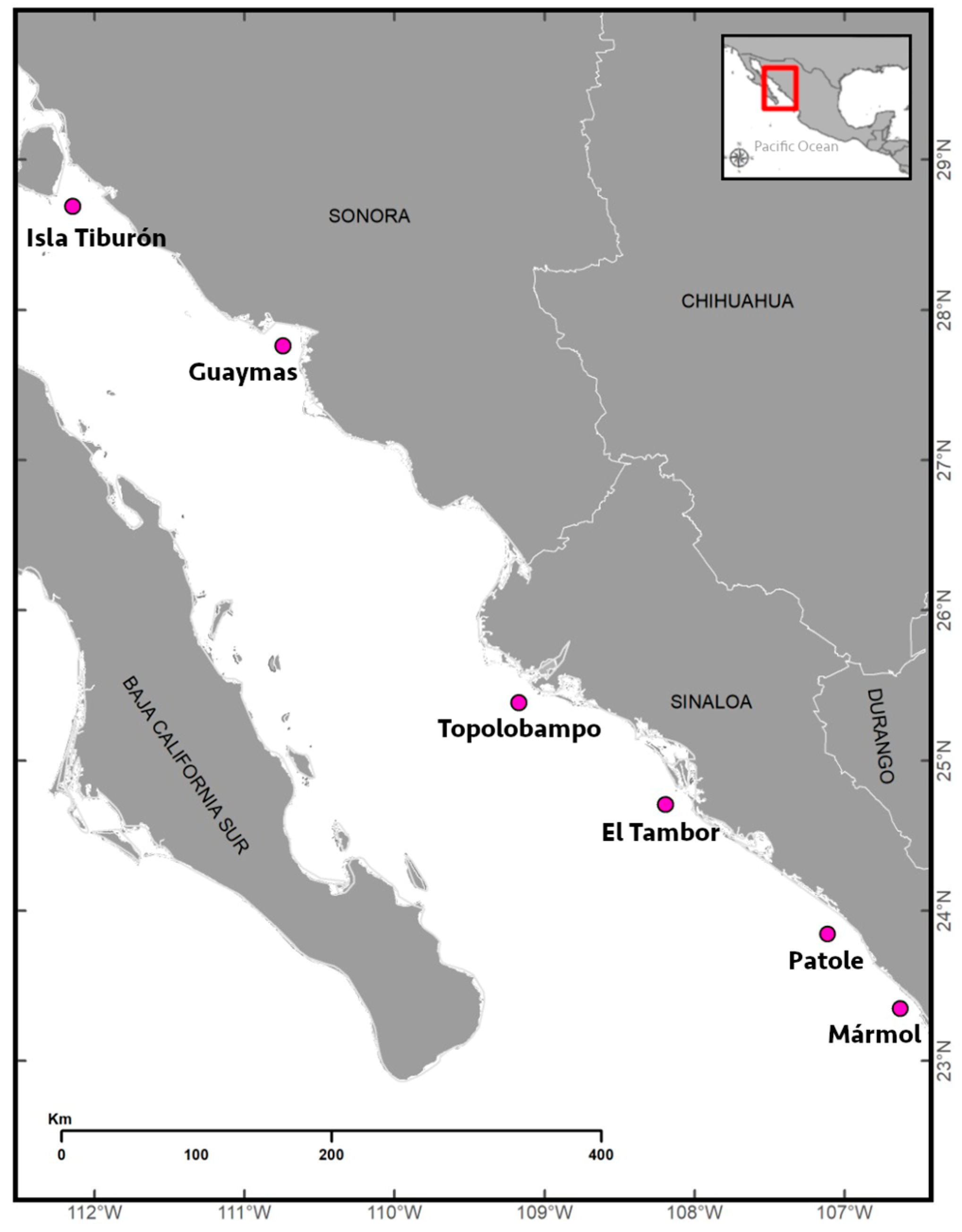
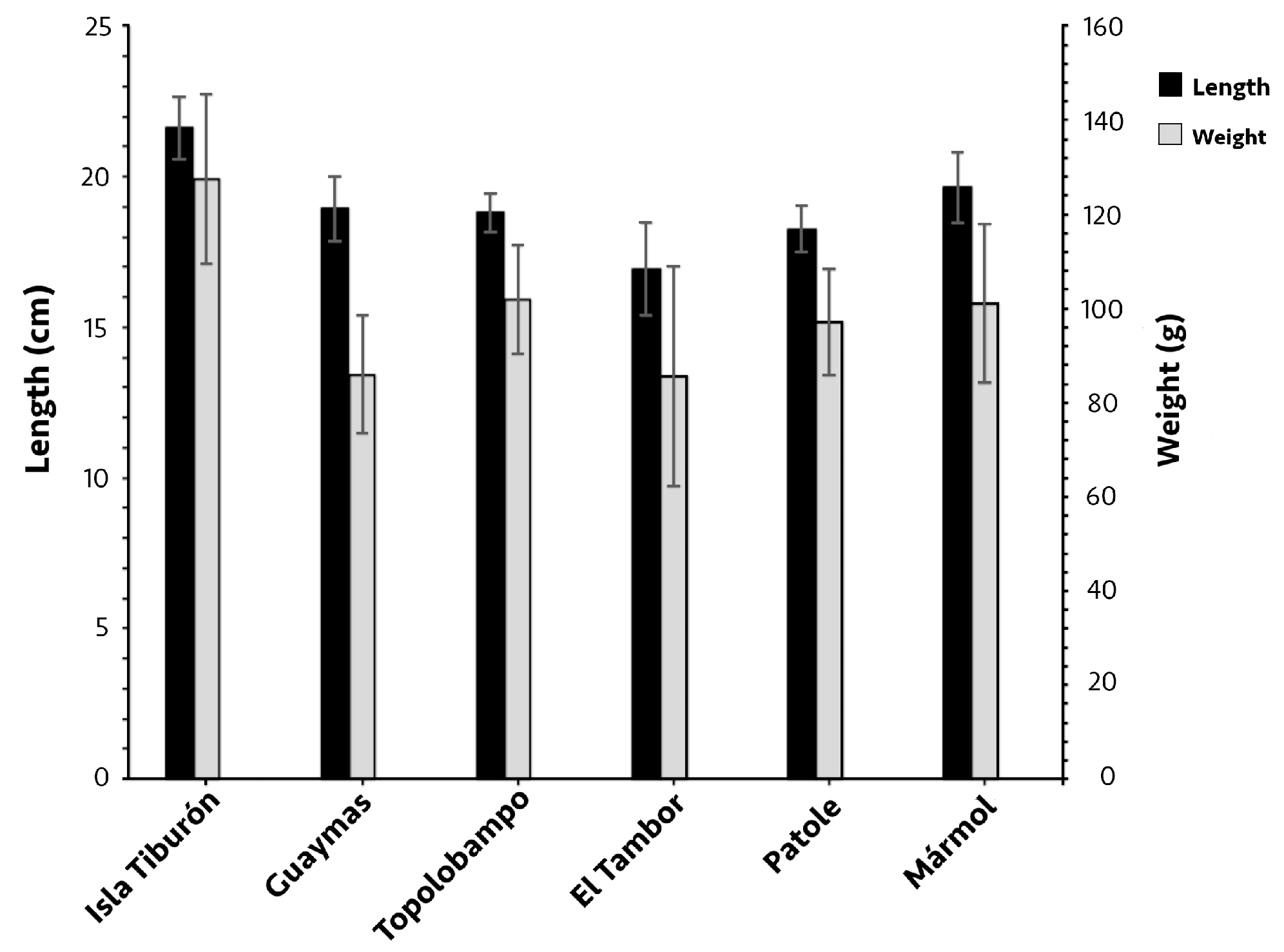

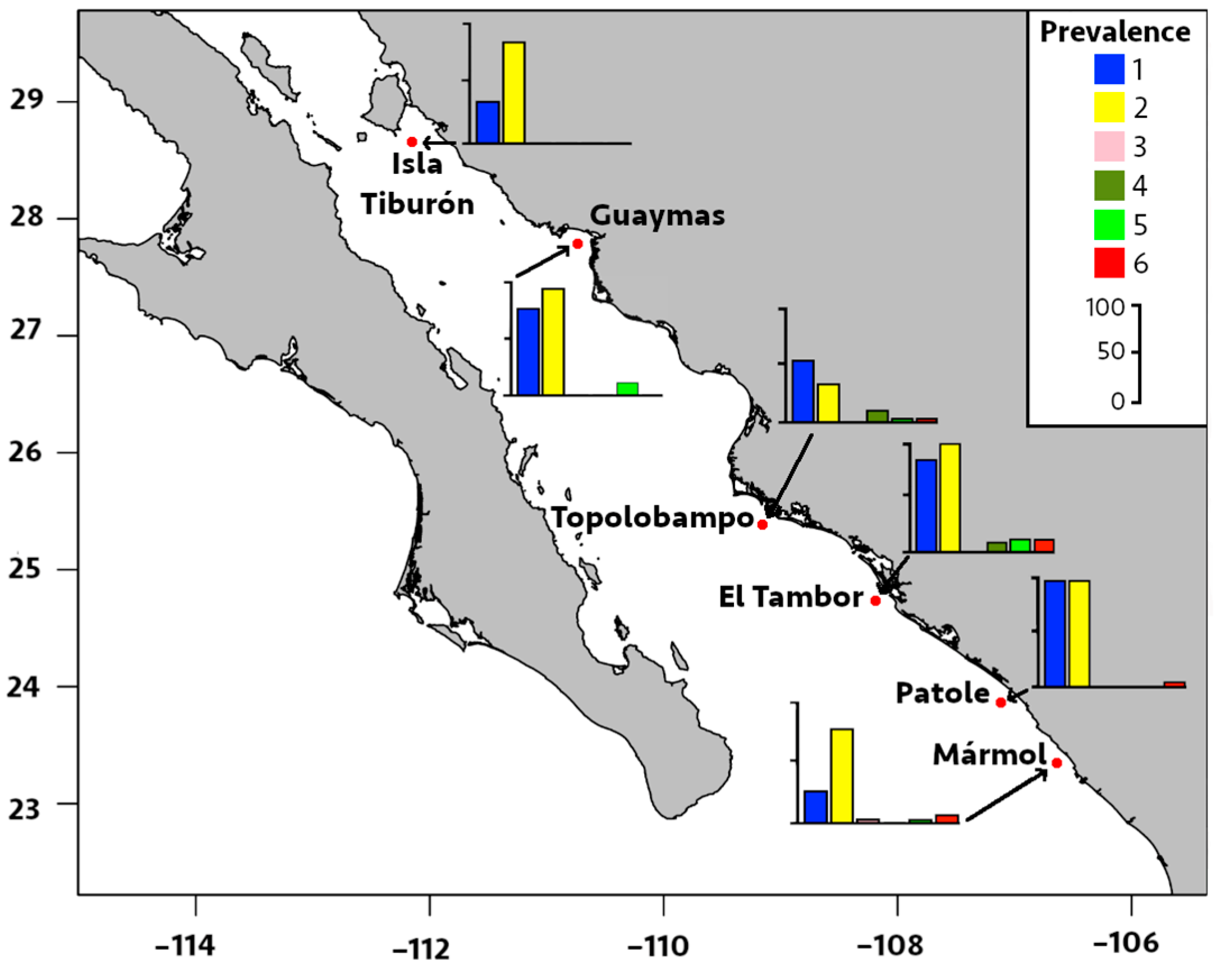
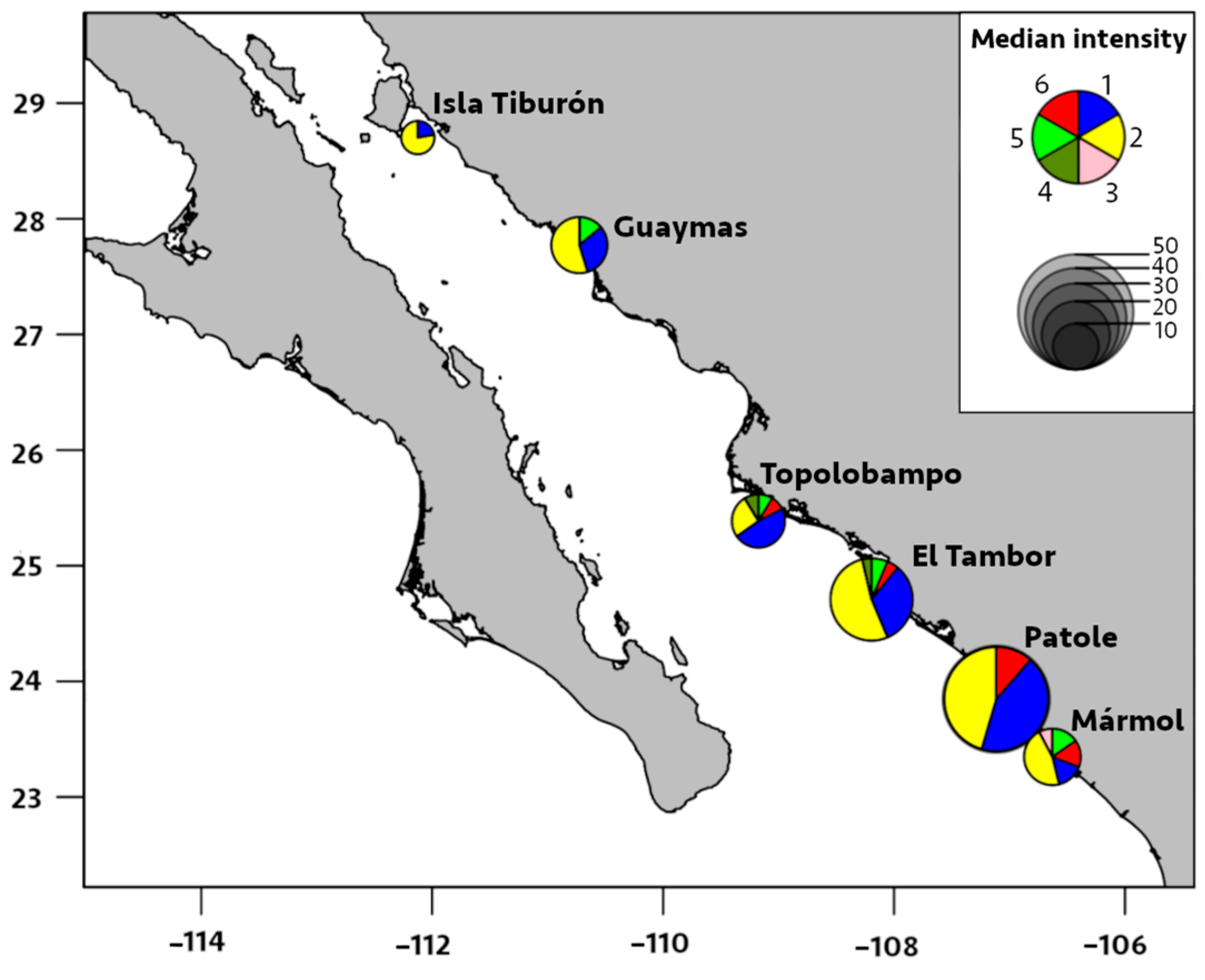
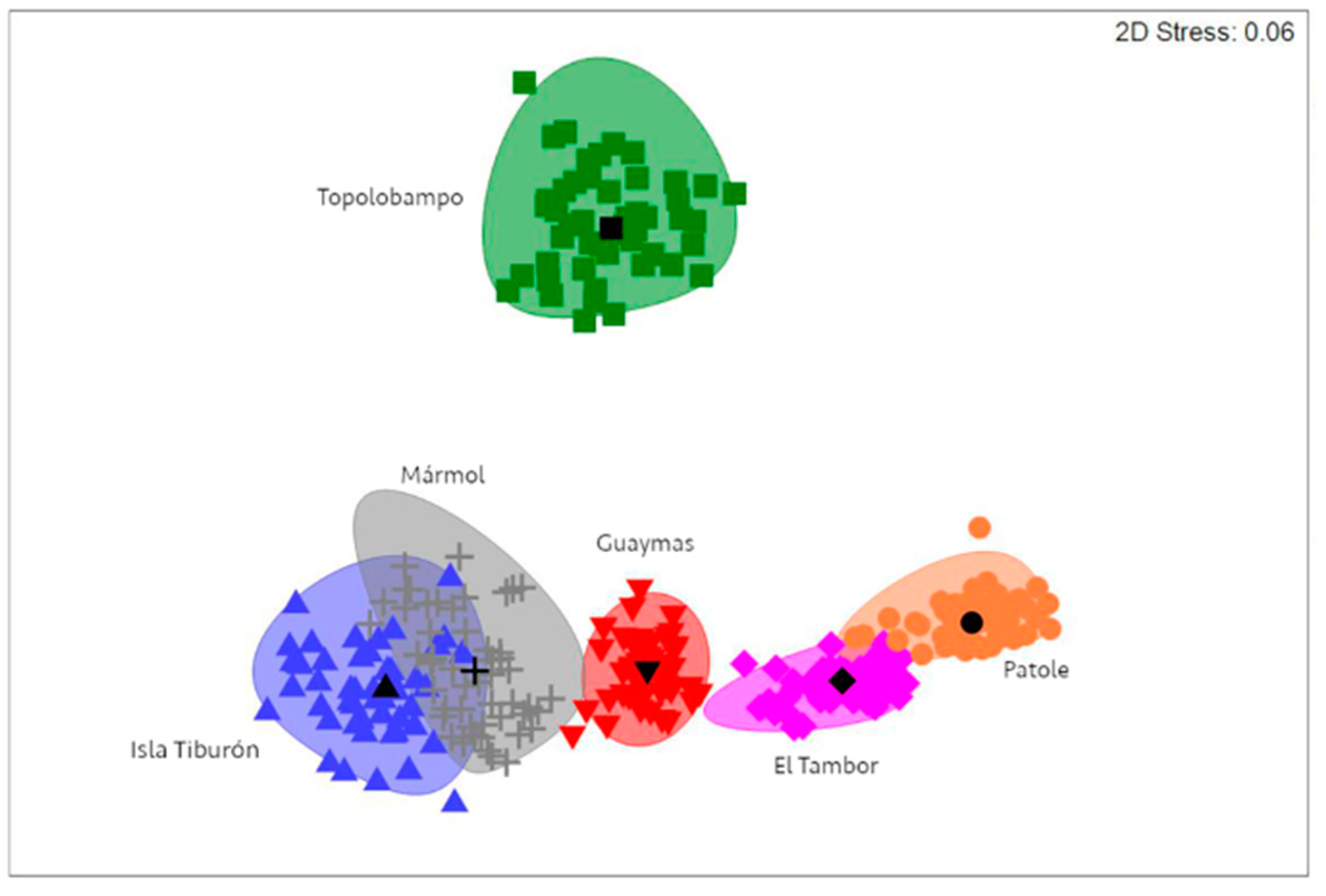
| Locality | Latitude, Longitude | Depth (m) | Temperature (°C) | n |
|---|---|---|---|---|
| Isla Tiburón | 28°70′15.3″ N, 112°12′46.9″ W | 45 | 30.2 | 38 |
| Guaymas | 27°77′20.9″ N, 110°72′53.3″ W | 47 | 28.8 | 57 |
| Topolobampo | 25°23′89.6″ N, 109°90′85.7″ W | 15 | 27.9 | 48 |
| El Tambor | 24°43′12.9″ N, 108°10′42.3″ W | 15 | 27.7 | 34 |
| Patole | 23°51′49.6″ N, 106°36′45.9″ W | 15 | 27.8 | 28 |
| Mármol | 23°21′46.1″ N, 106°36′45.9″ W | 15 | 27.9 | 52 |
| Parasite | Isla Tiburón | Guaymas | Topolobampo | El Tambor | Patole | Mármol | |
|---|---|---|---|---|---|---|---|
| Myosaccium ecaude | P% | 34(19–51) a,c | 75(62–85) b | 54(39–68) c | 85(68–95) b,d | 96(81–99) d | 26(15–41) a |
| MI | 1(1–2) a | 4(2–6) a,d | 5.5(2–8) c,d | 9(5–18) c | 19(9–26) b | 2(1–29) a,b,c | |
| Parahemiurus merus | P% | 84(68–94) a,b | 93(83–98) a, e | 33(20–48) c | 100(89–100) e | 96(81–99) a,e | 78(65–88) b,d |
| MI | 3.5(2–5) a,b | 7(5–9) a,e | 3(1–8) b,d | 14.5(10–23) f | 20(15–41) c,f | 6(5–10) e | |
| Pseudoterranova sp. | P% | 0 | 0 | 0 | 0 | 0 | 1(0–10) |
| MI | 0 | 0 | 0 | 0 | 0 | 1(0.9–1) | |
| Lepeophtheirus sp. | P% | 0 | 0 | 10(3–22) | 8(1–23) | 0 | 0 |
| MI | 0 | 0 | 1(0.7–1.2) | 1(0.9–1.1) | 0 | 0 | |
| Cribromazocraes cf. travassosi | P% | 0 | 10(4–21) | 2(0–11) | 11(3–27) | 0 | 1(0–10) |
| MI | 0 | 1.8(1–3) | 1(0.9–1.1) | 1.75(1.5–1.9) | 0 | 2(1.9–2) | |
| Mazocraeoides georgei | P% | 0 | 0 | 2(0–11) | 11(3–27) | 3(1–18) | 5(1–15) |
| MI | 0 | 0 | 1(0.9–1.01) | 1.25(1.1–1.3) | 5(4.6–5.3) | 2(1.8–2.1) |
| Data | Source | d.f. | SS | MS | Pseudo F | Pperm |
|---|---|---|---|---|---|---|
| Both parasites (Bray–Curtis similarity) | Host size | 1 | 26,768 | 26,768 | 14.23 | <0.01 |
| Locality | 5 | 85,006 | 17,001 | 9.03 | <0.01 | |
| Host size x Locality | 5 | 8686.60 | 1737.3 | 0.92 | >0.05 | |
| Residual | 245 | 4.60 e5 | 1880.9 | |||
| Total | 256 | 5.81 e5 |
Disclaimer/Publisher’s Note: The statements, opinions and data contained in all publications are solely those of the individual author(s) and contributor(s) and not of MDPI and/or the editor(s). MDPI and/or the editor(s) disclaim responsibility for any injury to people or property resulting from any ideas, methods, instructions or products referred to in the content. |
© 2023 by the authors. Licensee MDPI, Basel, Switzerland. This article is an open access article distributed under the terms and conditions of the Creative Commons Attribution (CC BY) license (https://creativecommons.org/licenses/by/4.0/).
Share and Cite
López-Moreno, D.G.; Vallarta-Zárate, J.R.F.; Marín-Enríquez, E.; Amezcua, F.; Morales-Serna, F.N. Looking for Parasites as Potential Biological Tags for Pacific Thread Herring, Opisthonema libertate (Günther, 1867) (Clupeiformes, Dorosomatidae), in the Gulf of California. Fishes 2023, 8, 336. https://doi.org/10.3390/fishes8070336
López-Moreno DG, Vallarta-Zárate JRF, Marín-Enríquez E, Amezcua F, Morales-Serna FN. Looking for Parasites as Potential Biological Tags for Pacific Thread Herring, Opisthonema libertate (Günther, 1867) (Clupeiformes, Dorosomatidae), in the Gulf of California. Fishes. 2023; 8(7):336. https://doi.org/10.3390/fishes8070336
Chicago/Turabian StyleLópez-Moreno, Dania Guadalupe, Juan Roberto Felipe Vallarta-Zárate, Emigdio Marín-Enríquez, Felipe Amezcua, and Francisco Neptalí Morales-Serna. 2023. "Looking for Parasites as Potential Biological Tags for Pacific Thread Herring, Opisthonema libertate (Günther, 1867) (Clupeiformes, Dorosomatidae), in the Gulf of California" Fishes 8, no. 7: 336. https://doi.org/10.3390/fishes8070336
APA StyleLópez-Moreno, D. G., Vallarta-Zárate, J. R. F., Marín-Enríquez, E., Amezcua, F., & Morales-Serna, F. N. (2023). Looking for Parasites as Potential Biological Tags for Pacific Thread Herring, Opisthonema libertate (Günther, 1867) (Clupeiformes, Dorosomatidae), in the Gulf of California. Fishes, 8(7), 336. https://doi.org/10.3390/fishes8070336







